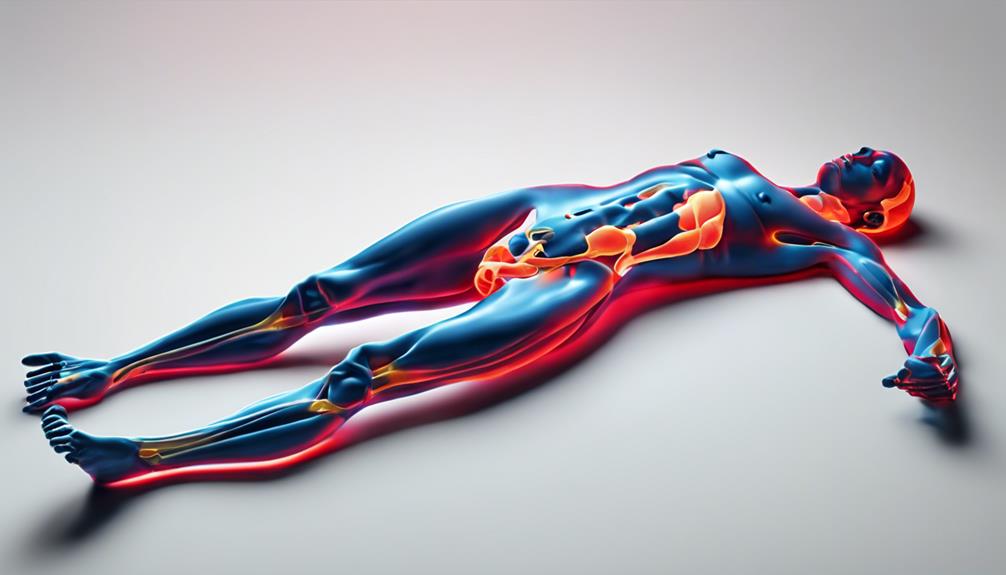The Vital Psoas Muscle by Jo Ann Staugaard-Jones – Summary and Review

The Vital Psoas Muscle – Key player in physical well-being, connecting spine to legs. Essential for posture, movement, and emotional health.
Uncover profound link between physical and emotional states. Impact on overall well-being and vitality.
Key Takeaways
- The psoas muscle's anatomy and function are crucial for movement and posture support.
- Understanding the location and importance of the psoas muscle empowers physical well-being.
- Functional benefits include enhancing flexibility, core stability, and overall physical health.
- Caring for the psoas muscle promotes spine support, emotional health, and holistic well-being.
Importance of the Psoas Muscle
In modern society, the psoas muscle plays an essential role in maintaining overall bodily function and mobility. This deep-seated muscle not only supports the spine but also aids in flexing the hips and legs, important for movements like walking, running, and even sitting. The flexibility and mobility of the psoas muscle are integral to a healthy and active lifestyle, allowing individuals to engage in various physical activities with ease and grace.
Additionally, the psoas muscle contributes greatly to injury prevention. A strong and well-conditioned psoas muscle helps stabilize the spine and pelvis, reducing the risk of strains and imbalances that could lead to discomfort or injury. By incorporating exercises that target the psoas muscle, individuals can enhance their overall strength and resilience, safeguarding themselves against potential harm during daily movements or more strenuous physical endeavors.
Understanding the importance of the psoas muscle in promoting flexibility, mobility, and injury prevention empowers individuals to prioritize its care and maintenance, fostering a foundation of strength and well-being.
Anatomy and Function
The psoas muscle, located deep within the abdomen, plays a vital role in stabilizing the spine and supporting proper posture. Its function extends beyond mere movement, as it's integral to activities like walking, running, and even sitting.
Understanding the anatomy and function of the psoas muscle is essential for maintaining overall strength and flexibility in the body.
Psoas Muscle Location
Nestled deep within the core of the body, the psoas muscle plays an important role in the intricate dance of movement and stability. As one of the primary hip flexors, the psoas muscle enables actions like lifting the knee and bending at the waist, contributing to flexibility and range of motion.
Its connection to the lower back is essential, as a healthy psoas muscle can aid in relieving lower back pain by providing support and alignment to the spine. Understanding the location of the psoas muscle allows individuals to appreciate its significance in maintaining proper posture, supporting the organs, and facilitating smooth, pain-free movements.
Embracing the awareness of this deep-seated muscle can empower individuals on their journey towards physical freedom and well-being.
Psoas Muscle Function
Deeply intertwined with the core of the body, the psoas muscle's intricate function in movement and stability is a marvel of anatomical brilliance. This powerful muscle plays an essential role in various bodily functions, including:
- Muscle Activation: The psoas muscle is involved in initiating movements such as walking, running, and bending at the waist, providing necessary support and strength to the body.
- Flexibility Training: Incorporating specific exercises targeting the psoas muscle can enhance flexibility, improve posture, and reduce the risk of injuries, making it crucial for overall physical well-being.
- Core Stability: Acting as a bridge between the lower and upper body, the psoas muscle contributes to core stability, promoting balance and coordination in daily activities.
Understanding and nurturing the psoas muscle is key to maintaining a healthy and functional body.
Importance of Psoas
Woven intricately within the core of the body, the psoas muscle's significance lies in its pivotal role in movement and stability. Psoas health and flexibility are essential for overall well-being. A healthy psoas allows for fluid movement and supports proper posture.
Strengthening techniques, such as targeted exercises and mindful stretching, can help maintain the psoas muscle's peak function. Benefits of a strong and flexible psoas include improved core strength, reduced risk of injury, and enhanced performance in various physical activities.
Posture and Spine Support
The alignment of the spine is important for maintaining good posture and providing support to the body.
Core strength plays a critical role in stabilizing the spine and promoting proper alignment.
Understanding the relationship between core strength, alignment, and stability can greatly enhance one's overall posture and spinal health.
Core Strength Importance
Strengthening the core muscles is essential for maintaining proper posture and providing support to the spine. When the core muscles are strong and balanced, they help stabilize the body and prevent slouching or overarching of the spine.
Here are three key benefits of core strength for posture and spine support:
- Core Stability: A strong core helps keep the spine aligned and stable, reducing the risk of injury and promoting overall balance.
- Flexibility: Alongside strength training, core flexibility is vital for allowing the spine to move freely in all directions, supporting a healthy range of motion.
- Balance: Core strength enhances the body's ability to stay upright and steady, improving posture and reducing strain on the spine.
Alignment and Stability
To maintain proper posture and spine support, ensuring alignment and stability is essential for overall body function and health. Vital and balance play critical roles in preventing injuries and promoting a sense of ease in daily movements.
The alignment of the body affects how weight is distributed, impacting joint health and muscle efficiency. When the body is properly aligned, there's a decreased strain on the spine, allowing for better support and reduced risk of discomfort.
Strength and flexibility in the muscles surrounding the spine are essential for maintaining alignment and stability. By incorporating exercises that focus on improving core strength and flexibility, individuals can enhance their posture, support the spine, and move with greater ease and freedom.
Emotional and Physical Health
Exploring the intricate connection between the psoas muscle and emotional well-being reveals a profound link between physical and mental health. The psoas muscle, often referred to as the 'muscle of the soul,' plays a vital role in both our emotional and physical well-being.
Here are three ways in which the psoas muscle impacts our overall health:
- Emotional Release: Tension stored in the psoas muscle can reflect emotional stress and trauma. Releasing this tension through targeted exercises can lead to a sense of emotional release and relief, promoting a healthier state of mind.
- Body Awareness: Strengthening and stretching the psoas muscle can enhance body awareness, allowing individuals to better understand how emotional stress manifests physically. This increased awareness can lead to a deeper connection between the mind and body.
- Energy Flow: A relaxed and balanced psoas muscle can improve energy flow throughout the body, promoting a sense of vitality and well-being. This enhanced energy flow can contribute to mental clarity and stress relief, fostering a more harmonious mind-body connection.
Practical Exercises
Enhancing your well-being through practical exercises for the psoas muscle can greatly impact both your physical and emotional health. Functional exercises that target the psoas can help improve your overall movement patterns and posture, leading to reduced pain and increased mobility. Incorporating a stretching routine specifically designed to release tension in the psoas can also contribute to a sense of ease and relaxation in both body and mind.
Functional exercises for the psoas muscle may include movements like lunges, leg lifts, or gentle hip flexor stretches. These exercises not only strengthen the psoas but also promote stability in the pelvis and spine. Additionally, a regular stretching routine focusing on the psoas can help alleviate tightness and discomfort in the lower back and hips, allowing for greater freedom of movement.
Impact on Movement
The psoas muscle's condition heavily influences one's overall movement capabilities. When the psoas is well-maintained, it enhances movement efficiency, reducing the risk of injuries. Here are three key ways the psoas impacts movement:
- Fluidity in Motion: A healthy psoas allows for smooth and coordinated movements, promoting a sense of freedom in physical activities. It supports the body's ability to move with grace and ease, enhancing overall performance in various exercises and daily tasks.
- Flexibility and Strength Balance: The psoas plays a critical role in maintaining a balance between flexibility and strength in the body. When in harmony, this muscle provides stability during dynamic movements while allowing for a full range of motion. This balance is essential for preventing strains and imbalances that can hinder the best movement patterns.
- Injury Prevention: A well-functioning psoas muscle contributes to better posture and alignment, reducing the likelihood of overuse injuries. By supporting the spine and pelvis, the psoas helps distribute the body's weight evenly, decreasing stress on other muscles and joints. This, in turn, promotes a more sustainable and injury-free movement practice.
Overall Well-being
Nurturing the vital psoas muscle fosters a profound sense of overall well-being, intertwining physical and mental harmony. The mind-body connection is a powerful aspect of holistic health, where the psoas muscle plays a significant role. By incorporating mindfulness practices into one's routine, individuals can enhance their awareness of this muscle, leading to stress relief and a deeper connection to their body.
| Mind-Body Connection | Stress Relief | Holistic Health | Mindfulness Practice |
|---|---|---|---|
| Strengthens the bond between the body and mind | Helps alleviate tension and anxiety | Considers the whole person, focusing on physical, mental, and emotional well-being | Encourages present-moment awareness and self-care |
Understanding the interconnectedness of the psoas muscle with overall well-being can inspire individuals to prioritize its care, resulting in a more balanced and fulfilling lifestyle. By acknowledging the importance of this muscle and incorporating practices that support its health, individuals can experience a profound sense of vitality and harmony.
Frequently Asked Questions
Can the Psoas Muscle Affect Digestion and Bowel Movements?
The psoas muscle, essential for posture, may influence digestion and bowel movements due to its proximity to organs. Its relationship with breathing can impact abdominal pressure, potentially affecting gut function and comfort.
How Does Emotional Stress Impact the Psoas Muscle?
When stress mounts, the mind-body connection tightens the psoas muscle, often causing tensions. Proper stress management techniques like mindfulness, yoga, or therapeutic practices can release these tensions, restoring balance and alleviating emotional stress impacts on the psoas muscle.
Are There Any Specific Stretches or Exercises That Can Help Alleviate Psoas Muscle Tension During Pregnancy?
Prenatal exercises can help alleviate psoas muscle tension during pregnancy. Incorporating gentle stretches and Psoas release techniques into a routine can provide relief and support overall well-being for expecting mothers.
Can a Sedentary Lifestyle Lead to Chronic Issues With the Psoas Muscle?
A sedentary lifestyle can lead to health concerns, including chronic issues with the psoas muscle. It's crucial to incorporate movement into daily routines to maintain flexibility and prevent stiffness in this important muscle group.
Is There a Connection Between the Psoas Muscle and Hip Flexibility in Athletes?
Athletic performance can soar with a supple psoas muscle. Flexibility training opens the door to enhanced hip flexibility in athletes, paving the way for improved agility and range of motion, essential for achieving peak performance on the field.











